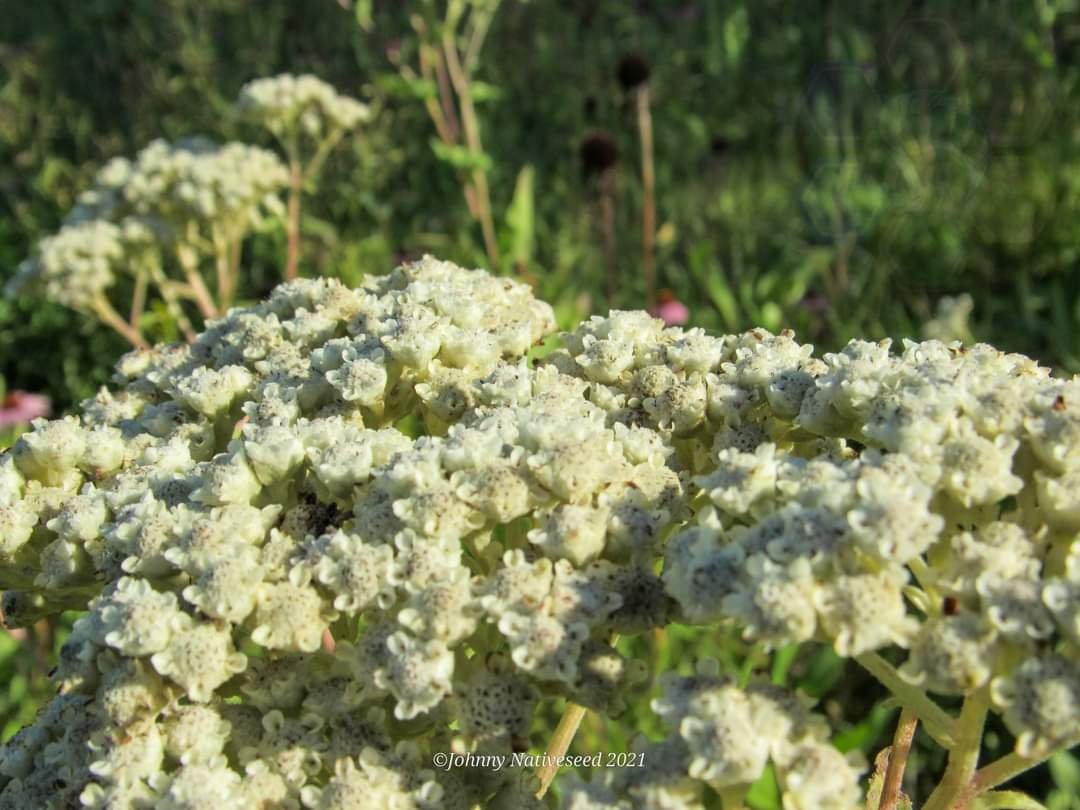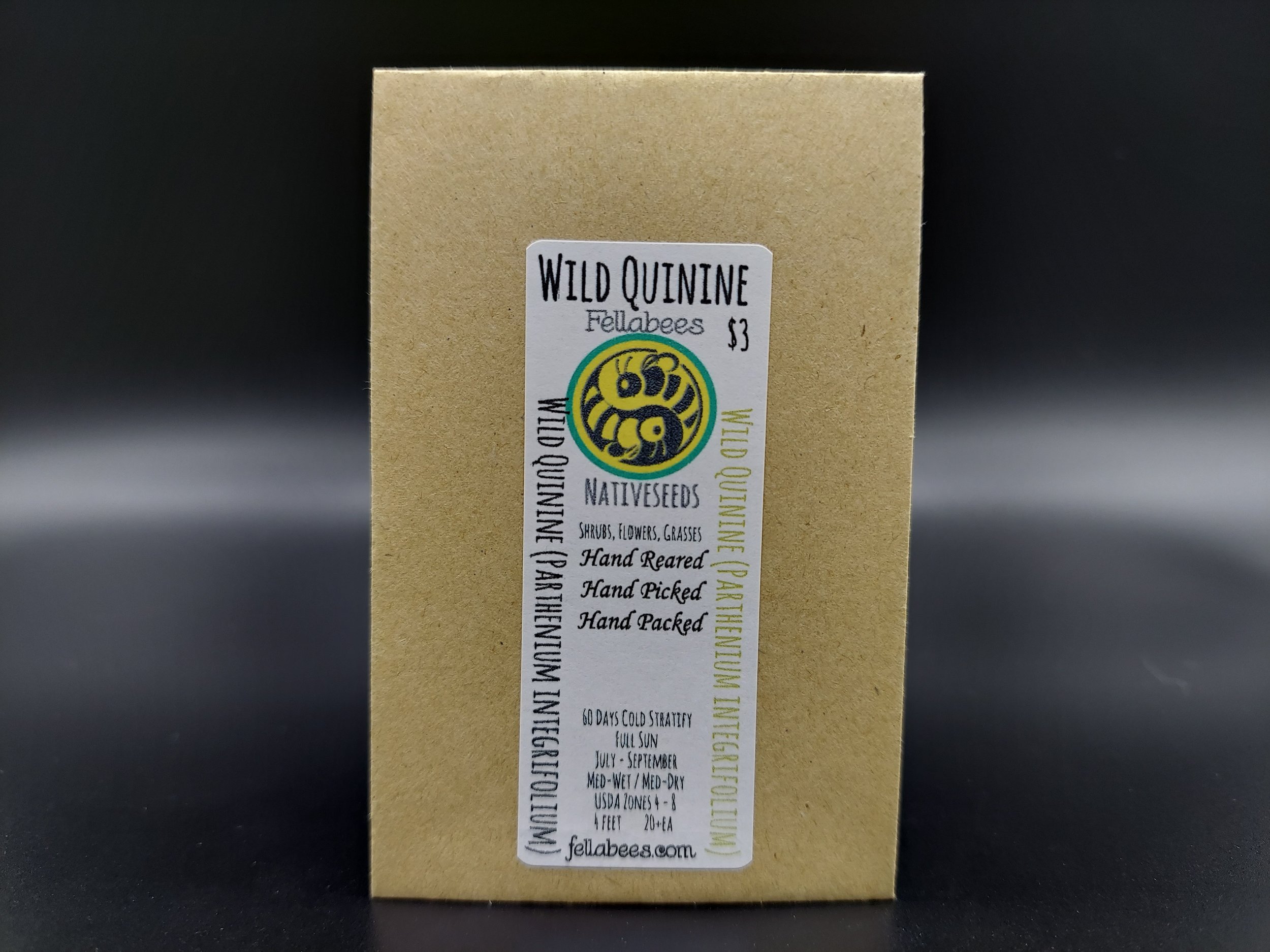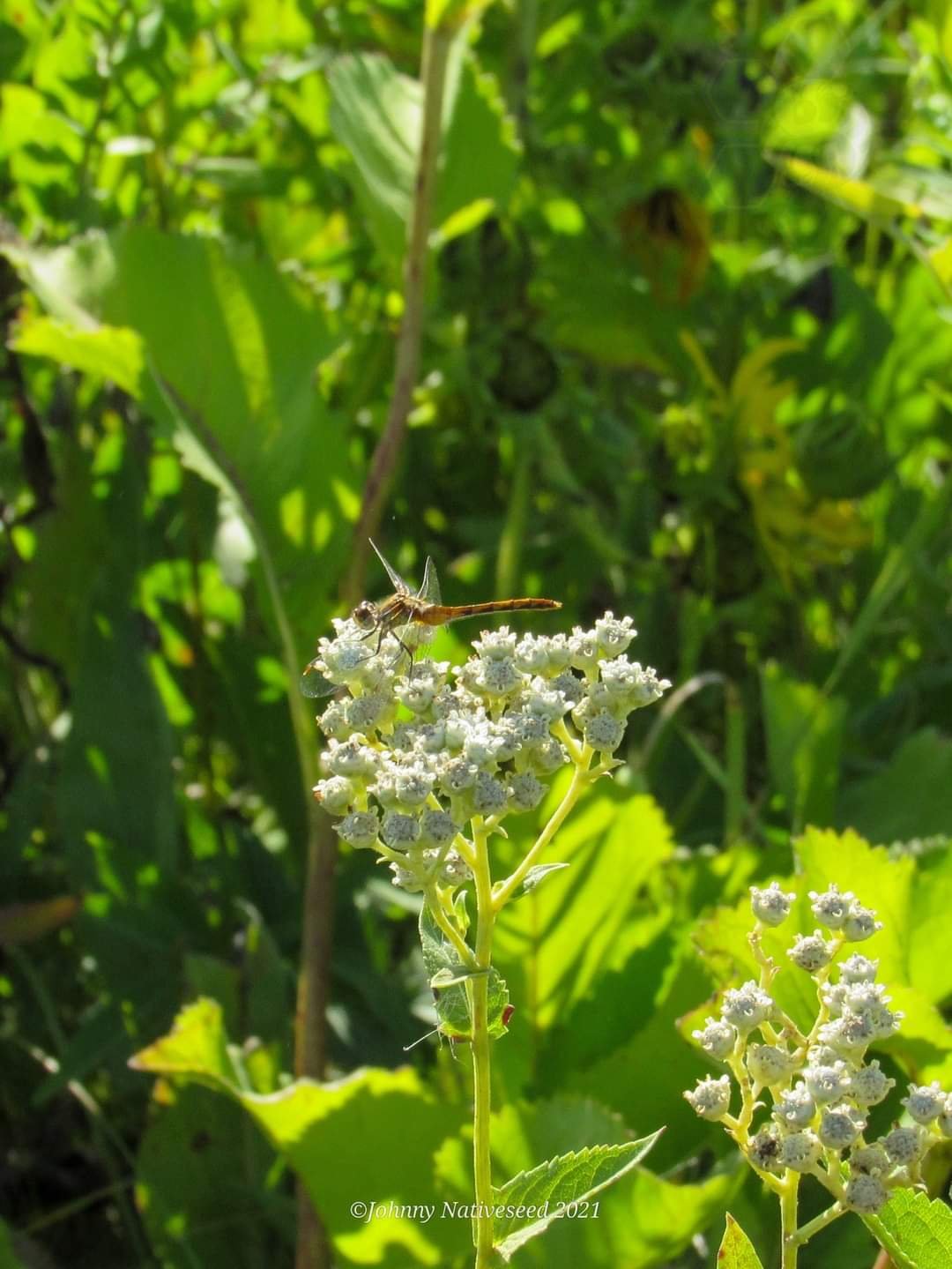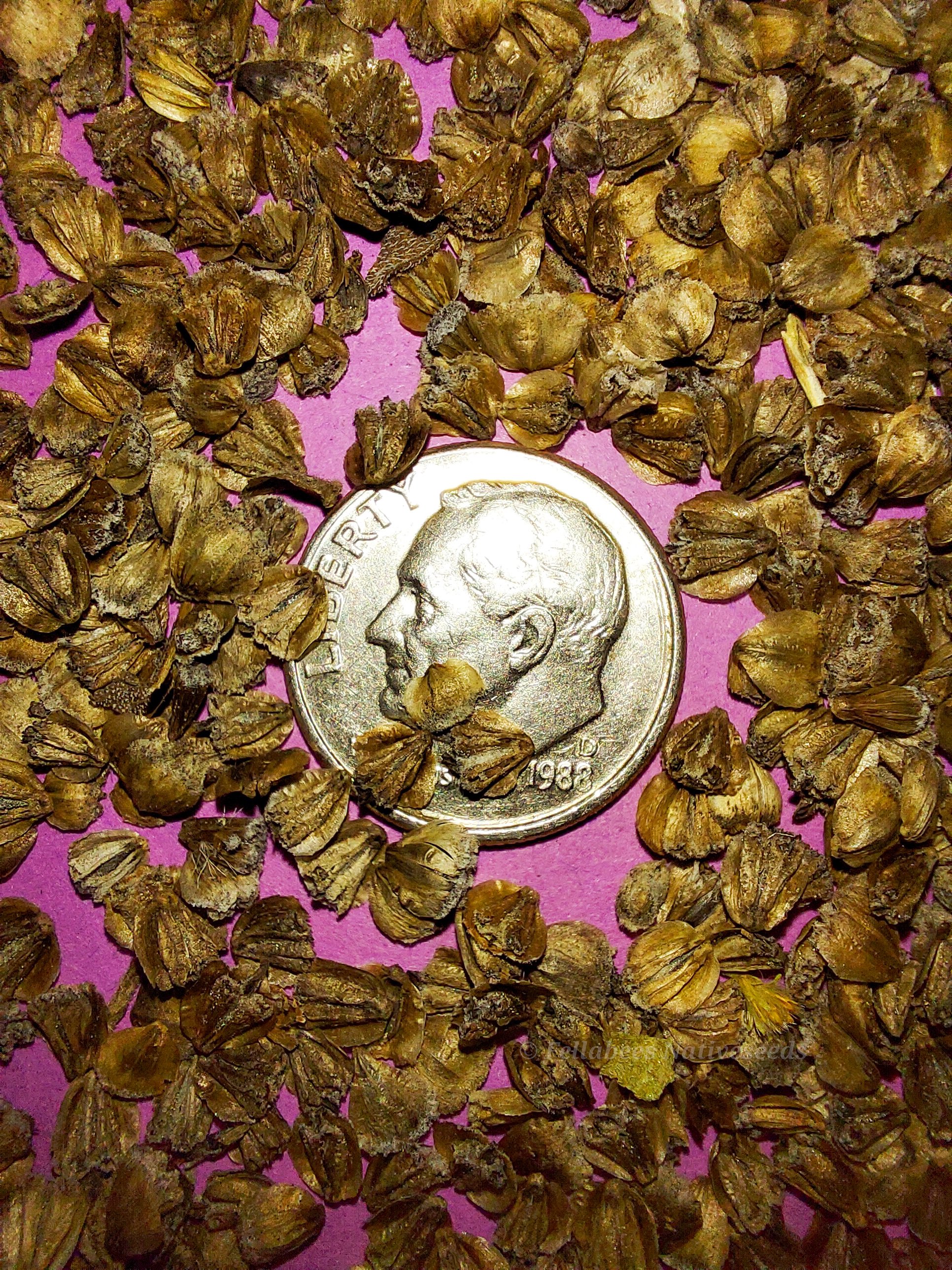 Image 1 of 4
Image 1 of 4

 Image 2 of 4
Image 2 of 4

 Image 3 of 4
Image 3 of 4

 Image 4 of 4
Image 4 of 4





Wild Quinine (Parthenium integrifolium)
Wild Quinine (Parthenium integrifolium)
Parthenium integrifolium is a species of flowering plant in the aster family known by the common names wild quinine, American feverfew, and eastern feverfew. It is native to the eastern and midwestern United States.
This plant grows in disturbed areas as well as prairies, meadows, woodland edges, and hillsides. It does best in full sun, but does well enough in partial shade. It grows in almost any well-drained soil from sandy loam to good quality clay. It tolerates hot and cold climates and can be used as a garden plant in many areas. It has an especially long blooming period of June into September; one of the longer blooming perennials. The winter inflorescences (flowers) are attractive and make a good dried flower arrangement for indoors.
Wild Quinine, when grown from seed indoors, requires special treatment in order to unlock its ability to germinate. To artificially simulate its requirements it needs to be Cold Stratified for at least 60 days.
It can be direct sown in late fall, even directly on top of snow if planted outside. Do not bury the seed. The expanding and contracting of soil under the freeze thaw cycles will put the seed in its ideal position before the warming temperatures of spring.
Ethnobotanically, the leaves and the tuberous roots have been the only known portions of the plants used.
Several Indigenous American tribes used Wild Quinine burned leaves made into a poultice to treat burns, and tea made from the leaves of the plant to treat dysentery. Wild quinine also has had veterinarian medicine properties as well.
The first waves of European colonists incursion into the Native Peoples North America, soon found that wild quinine treated fevers, coughs, and sore throats.
In modernity, Wild Quinine is described to have antibacterial, antiseptic, and immunostimulant properties. It is also indicated for general bacteria, bronchitis, colitis, “cold,” cough, fatigue, immunodepression, and non-specific infections.
In the relative recent history of World War I, the cinchona tree, whose bark provides the ingredient of true quinine, was in short supply, wild quinine was substituted to treat malaria.
Plant Details
USDA Zones: 4-8
Germination Needs: 60 Days Cold Stratification,
Life Cycle: Perennial
Sun Exposure: Full Sun
Soil Moisture: Medium-Wet, Medium, Medium-Dry
Plant Spacing: 1-2 feet
Height: 4 feet
Bloom time: June, July, August, September
Bloom Color: White
Advantages :
Pollinator Favorite: butterflies, moths, bees, wasps, beetles
Deer Resistant: Yes
Excellent in the home landscape!
.
.
Packet quantities:
We pride ourselves on ethical, hands on, ecological management, using no mechanical or chemical methods whatsoever.
All of our native seed is hand reared, hand picked, and hand packed from native prairies under our exclusive management, never breaking chain of custody from the field until it is sent to you. Each packet is hand prepared for shipment by us, directly.
Small seed species will contain greater than 20-25 seed
Large seed species will contain greater than 10-15 seed
It is our mission to spread the wealth of native plant and pollinator ecological sustainability, and educate back yard gardeners as well as cooperate and government entities in how to germinate, grow, and benefit from native synergies.
Thank you for your support, it is because of you, that we can grow together to do, what we do.🐛🦋🐝🐞🌾🌱🌼🧡
Wild Quinine (Parthenium integrifolium)
Parthenium integrifolium is a species of flowering plant in the aster family known by the common names wild quinine, American feverfew, and eastern feverfew. It is native to the eastern and midwestern United States.
This plant grows in disturbed areas as well as prairies, meadows, woodland edges, and hillsides. It does best in full sun, but does well enough in partial shade. It grows in almost any well-drained soil from sandy loam to good quality clay. It tolerates hot and cold climates and can be used as a garden plant in many areas. It has an especially long blooming period of June into September; one of the longer blooming perennials. The winter inflorescences (flowers) are attractive and make a good dried flower arrangement for indoors.
Wild Quinine, when grown from seed indoors, requires special treatment in order to unlock its ability to germinate. To artificially simulate its requirements it needs to be Cold Stratified for at least 60 days.
It can be direct sown in late fall, even directly on top of snow if planted outside. Do not bury the seed. The expanding and contracting of soil under the freeze thaw cycles will put the seed in its ideal position before the warming temperatures of spring.
Ethnobotanically, the leaves and the tuberous roots have been the only known portions of the plants used.
Several Indigenous American tribes used Wild Quinine burned leaves made into a poultice to treat burns, and tea made from the leaves of the plant to treat dysentery. Wild quinine also has had veterinarian medicine properties as well.
The first waves of European colonists incursion into the Native Peoples North America, soon found that wild quinine treated fevers, coughs, and sore throats.
In modernity, Wild Quinine is described to have antibacterial, antiseptic, and immunostimulant properties. It is also indicated for general bacteria, bronchitis, colitis, “cold,” cough, fatigue, immunodepression, and non-specific infections.
In the relative recent history of World War I, the cinchona tree, whose bark provides the ingredient of true quinine, was in short supply, wild quinine was substituted to treat malaria.
Plant Details
USDA Zones: 4-8
Germination Needs: 60 Days Cold Stratification,
Life Cycle: Perennial
Sun Exposure: Full Sun
Soil Moisture: Medium-Wet, Medium, Medium-Dry
Plant Spacing: 1-2 feet
Height: 4 feet
Bloom time: June, July, August, September
Bloom Color: White
Advantages :
Pollinator Favorite: butterflies, moths, bees, wasps, beetles
Deer Resistant: Yes
Excellent in the home landscape!
.
.
Packet quantities:
We pride ourselves on ethical, hands on, ecological management, using no mechanical or chemical methods whatsoever.
All of our native seed is hand reared, hand picked, and hand packed from native prairies under our exclusive management, never breaking chain of custody from the field until it is sent to you. Each packet is hand prepared for shipment by us, directly.
Small seed species will contain greater than 20-25 seed
Large seed species will contain greater than 10-15 seed
It is our mission to spread the wealth of native plant and pollinator ecological sustainability, and educate back yard gardeners as well as cooperate and government entities in how to germinate, grow, and benefit from native synergies.
Thank you for your support, it is because of you, that we can grow together to do, what we do.🐛🦋🐝🐞🌾🌱🌼🧡
Wild Quinine (Parthenium integrifolium)
Parthenium integrifolium is a species of flowering plant in the aster family known by the common names wild quinine, American feverfew, and eastern feverfew. It is native to the eastern and midwestern United States.
This plant grows in disturbed areas as well as prairies, meadows, woodland edges, and hillsides. It does best in full sun, but does well enough in partial shade. It grows in almost any well-drained soil from sandy loam to good quality clay. It tolerates hot and cold climates and can be used as a garden plant in many areas. It has an especially long blooming period of June into September; one of the longer blooming perennials. The winter inflorescences (flowers) are attractive and make a good dried flower arrangement for indoors.
Wild Quinine, when grown from seed indoors, requires special treatment in order to unlock its ability to germinate. To artificially simulate its requirements it needs to be Cold Stratified for at least 60 days.
It can be direct sown in late fall, even directly on top of snow if planted outside. Do not bury the seed. The expanding and contracting of soil under the freeze thaw cycles will put the seed in its ideal position before the warming temperatures of spring.
Ethnobotanically, the leaves and the tuberous roots have been the only known portions of the plants used.
Several Indigenous American tribes used Wild Quinine burned leaves made into a poultice to treat burns, and tea made from the leaves of the plant to treat dysentery. Wild quinine also has had veterinarian medicine properties as well.
The first waves of European colonists incursion into the Native Peoples North America, soon found that wild quinine treated fevers, coughs, and sore throats.
In modernity, Wild Quinine is described to have antibacterial, antiseptic, and immunostimulant properties. It is also indicated for general bacteria, bronchitis, colitis, “cold,” cough, fatigue, immunodepression, and non-specific infections.
In the relative recent history of World War I, the cinchona tree, whose bark provides the ingredient of true quinine, was in short supply, wild quinine was substituted to treat malaria.
Plant Details
USDA Zones: 4-8
Germination Needs: 60 Days Cold Stratification,
Life Cycle: Perennial
Sun Exposure: Full Sun
Soil Moisture: Medium-Wet, Medium, Medium-Dry
Plant Spacing: 1-2 feet
Height: 4 feet
Bloom time: June, July, August, September
Bloom Color: White
Advantages :
Pollinator Favorite: butterflies, moths, bees, wasps, beetles
Deer Resistant: Yes
Excellent in the home landscape!
.
.
Packet quantities:
We pride ourselves on ethical, hands on, ecological management, using no mechanical or chemical methods whatsoever.
All of our native seed is hand reared, hand picked, and hand packed from native prairies under our exclusive management, never breaking chain of custody from the field until it is sent to you. Each packet is hand prepared for shipment by us, directly.
Small seed species will contain greater than 20-25 seed
Large seed species will contain greater than 10-15 seed
It is our mission to spread the wealth of native plant and pollinator ecological sustainability, and educate back yard gardeners as well as cooperate and government entities in how to germinate, grow, and benefit from native synergies.
Thank you for your support, it is because of you, that we can grow together to do, what we do.🐛🦋🐝🐞🌾🌱🌼🧡
